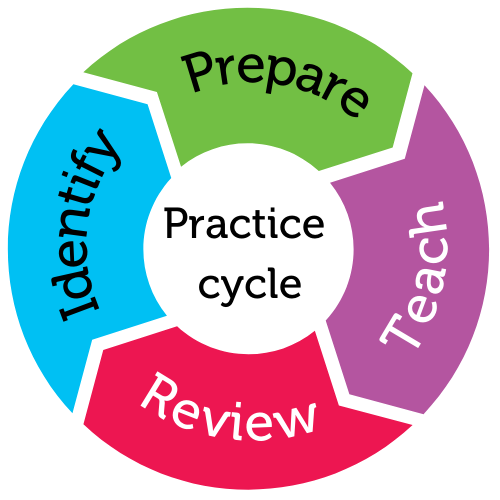
For student year
Helps students to
- write persuasive texts
- organise thoughts
- work independently
Helps teachers to
- promote student writing
- facilitate written expression
Summary
Some students, including those on the autism spectrum, struggle with looking at the big picture of an assignment or task. Being able to break down the tasks into smaller chunks can support students to complete assignments themselves. Using a strategy that can be replicated across different assignments can support students with independent study. By teaching this to the whole class it allows all students to have the opportunity to learn a strategy that can support them.
These difficulties may surface during writing tasks, and may result in students:
- writing vague or unclear statements
- creating writing that is difficult to follow, i.e. has poor textual coherence
- writing as they speak and not understand context and structure
- creating writing with weak structure.
Self-regulated strategy development (SRSD) has been shown to help students with their writing by scaffolding conceptual idea generation and sequencing.
SRSD is an approach that:
- supports students to independently plan, organise, sequence ideas, compose, and then revise their work
- uses memory aids, such as the POW+TREE mnemonic device, to scaffold writing.
How the practice works
Use this video to introduce the POW+TREE strategy to your students.
Duration: 4:33
Australian Professional Standards for Teachers related to this practice
3.3 - use teaching strategies
4.1 - support student participation
For further information, see Australian Professional Standards for Teachers AITSL page
Preparing to teach
Self-regulated strategy development (SRSD) improves:
- the quality and length of written compositions
- the number of essay elements used
- use of planning and self-monitoring when writing.
The POW+TREE writing strategy has been shown to be effective in improving the persuasive writing outcomes for students on the spectrum.
What is POW+TREE?
Pick an idea
Organise your notes
Write and say more
+
Topic sentence
Reasons (three or more)
Explain reasons
Ending and examine
Encourage students to learn what POW+TREE stands for, how to use it, and why it is helpful. Students may vary in their response to the strategy – some may require greater support, others will develop the skills to use the strategy automatically to guide their actions during persuasive writing tasks.
Identify scaffolds that will benefit students
By testing out various scaffolds and observing their impact and use, you can get to know the level of support that your students may need and the scaffolding that they may benefit from. Consider which aspects of a scaffold are seemingly used easily by the student and how this can build further skills. For example, a student may use the POW+TREE method and may struggle with the idea generation part (step P) but excel in the reasoning stage (step R). This means you can support them by choosing ideas or persuasive arguments for the student so they can then hone their skills in explaning reasons.
Some students also find the physical handwriting element of tasks to be the most challenging aspect. For those students, a written piece of text is not a true indication of their ability to compose a persuasive argument. Appropriate adjustments are described in the Use technology to support written expression practice.
In the classroom
Introduce POW+TREE to your classroom
- Use the ‘Introducing POW+TREE’ video above to introduce the strategy to your classroom. The introduction will enable you to teach students the types of strategies and scaffolds that you might decide to use in the classroom.
- Provide all students with the POW+TREE scaffolding guide for students (in Resources, below) and explain each part of the strategy.
- Initially, you may offer all students the opportunity to use any of the available scaffolds.
- As students begin to understand and construct persuasive texts, you may choose to forgo particular scaffolds as they progress with their own individual learning.
- The language you use with your students will influence students’ positive perception of scaffolds and their ability to determine if they need them.
Model the strategy
- Model how to use the POW+TREE strategy for your students. Some students will benefit from observing you model the strategy several times.
- You may need to use a range of prompts while students are learning the strategy, such as "Have you remembered to write at least three reasons?"
Watch an example modelled by a peer
- Have students practise presenting their own POW+TREE models to the rest of the class. Research shows that peer video-modelling is an effective strategy to promote engagement and learning for students on the autism spectrum.
- Provide students with examples of completed POW+TREE persuasive texts to support them to complete the writing task.
Encourage students to memorise the strategy
- Encourage all students to practise recalling and memorising the POW+TREE strategy. This will be particularly important for students who do not use any scaffolds.
- Have visual supports around the classroom to reinforce the strategy.
Practice toolkit
Practice implementation planner template
We know it's not always easy to keep track of what's working and what isn't. So, we've created this template for you to record and reflect on what you're doing to create more inclusive classrooms. The implementation planner contains:
- guidance around goal setting
- a reflection section (what worked, didn’t work, what to change, and next steps)
- prompting questions.
Implementation planner with examples
Set your professional learning goal for:
Supporting persuasive writing
Benefits of goal setting
Setting, working towards, and reflecting on goals helps you grow professionally and improve your practice. You can access AITSL learning resources for teachers to learn more about:How to set goals
The Australian Institute for Teaching and School Leadership recommends using the SMART matrix to frame your goal setting.SMART goals refers to goals that are:
- Specific
- Measurable
- Achievable
- Relevant
- Time-phased
Resources
POW+TREE scaffolding activities for teachers
This resource contains:
- What is POW+TREE?
- POW scaffolding for students
- POW+TREE checklist
- POW+TREE sentence starters
- POW+TREE shadow box prompts
POW+TREE scaffolding guide for students
Supporting persuasive writing - Practice Brief
Related Practices

Use technology to support written expression
TEACHING PRACTICE
For student years
Helps students to
- express ideas
- develop written expression
This practice is from the core research project
Learning Cycle

